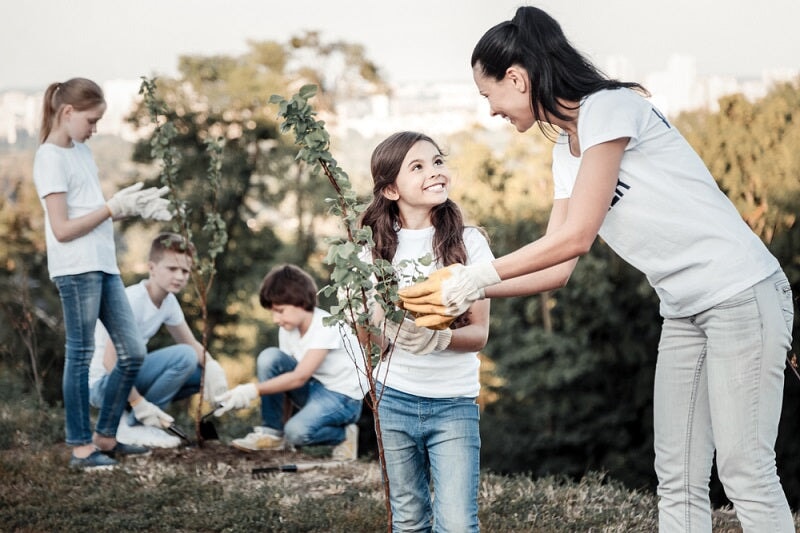
TLDR
It feels like scientists have always been talking about climate change. As far back as 1896, Swedish scientist Svante Arrhenius wrote about the greenhouse effect and its impact on Earth’s temperature.1 By the 1980s, activists were ringing alarm bells, and the public started paying closer attention.2
Since then, we’ve seen papers that predict the end of the world as we know it. But that hasn’t happened yet—so why should we care about climate change?
Although climate change is a crisis that requires immediate, drastic action, it can sometimes seem like nothing is happening or that only far-off parts of the world are at risk. In reality, climate change is everyone’s problem—even if the world isn’t going to end tomorrow, we’re headed down a dangerous path.
With that in mind, let’s consider seven reasons why you should care about climate change.
#1 Rising Water Levels Can Increase the Risk of Floods Climate Change Could Flood Your House
One of the most well-known effects of climate change is rising sea levels. As the global temperature increases due to greenhouse gas emissions, sea levels rise for two reasons:3
- Glaciers and ice sheets melt, adding volume to the oceans
- Water expands as it warms, causing the oceans to swell in size
All of this extra water has to go somewhere due to the rising sea level. Unfortunately for us, that “somewhere” is the land we live on. Specifically, rising seawater puts coastal cities at risk—and when you consider that coastal areas have always been centers of civilization, that’s bad news for millions of people and future generations.
By 2050, it’s estimated that more than one billion people will live in low-lying coastal zones.4 At the same time, best-case models suggest that sea levels could be 2 feet higher by 2100; worst-case models put that number at 7.2 feet.3
Even in the best-case scenario, millions of people will have to flee their homes because of the changing climate. Some of the most populated cities in the world could become hazardous or unlivable, including:5
- Amsterdam, Netherlands
- New Orleans, USA
- Bangkok, Thailand
- Dubai, UAE
- Manila, Philippines
- Dhaka, Bangladesh
- Mumbai, India
- Ho Chi Minh City, Vietnam
If these cities (and many others) become uninhabitable, millions of people will need to relocate.

#2 Climate Change Makes Severe Weather Worse
Flooding isn’t the only catastrophe that can occur if the climate crisis worsens. Climate change appears to increase the severity of several extreme weather events, such as:6
- Heat waves – Today, the U.S. experiences three times as many heat waves as it did in the 1960s. Recent heat waves have also lasted longer and have been more intense, ultimately affecting the global temperature.
- Heavy precipitation – Intense storms have brought heavy rainfall to many areas, and the problem has only worsened over time. Nine of the top ten years for severe one-day precipitation events are from the past 26 years.
- Hurricanes and tropical storms – Over the past 20 years, tropical storm activity has increased in the Caribbean, the Atlantic Ocean, and the Gulf of Mexico.
Although weather patterns do change naturally over time, the frequency and intensity of extreme weather we’re seeing are new—and concerning.
Ultimately, if you don’t want more catastrophic hurricanes, temperature variations, and heat waves, you should care about climate change.
#3 Climate Change Leads to Food Shortages
With changes in weather patterns come issues with food security.7 The crops we grow and the cattle we raise need food and water to thrive.
When heavy rains and tropical storms flood our farmland, crops and livestock can’t survive. And when droughts and heat waves last longer, are hotter and are more frequent, those plants and animals lack the water they need.
What’s more, climate change also threatens to disrupt the global food supply. Severe weather events can keep cargo ships from crossing the ocean, and floods and wildfires can cut off road and rail networks. Even if we can produce enough food, if we can’t transport it to the people that need it, it won’t do us any good.

#4 Climate Change is Bad for Your Health
Even if you manage to avoid natural disasters and continue to eat your fill, climate change can have other negative impacts on your well-being.
According to the CDC, climate change (and all its related phenomena) is harmful to human health.8 Between severe weather events and airborne pollution, climate change can increase the risk of:
- Heart disease
- Asthma
- Malaria
- Lyme disease
- Cholera
- Mental health problems
When you combine these issues with the added risk of malnutrition and injury from natural disasters, you can understand how climate change is a public health concern. So, if you value your well-being, you should care about climate change.
#5 Climate Change is Expensive
Dealing with food shortages, relocating environmental refugees, and cleaning up after intense weather events—all of these cost money.
In the U.S. alone, the number of billion-dollar disasters is increasing. As storms and droughts worsen, the economic impact increases, too. Here are some big numbers that highlight the cost of such natural disasters:9
- Hurricane Ida (2021) cost $75 billion
- Drought events in 2021 cost $8.9 billion
And where does this money come from? From you—in the form of taxes. So, if you’d rather have your tax dollars go toward improving infrastructure or social services, you should care about climate change.

#6 Climate Change Endangers Other Species
The climate crisis isn’t just a human problem; it’s a planetary problem. That’s right: Even though polar bears, turtles, and rhinos don’t contribute to pollution, they’re still at risk of extinction due to human activity.
Our oceans are becoming more acidic due to rising carbon dioxide (CO2) levels.10 As the acidity increases, coral reefs start to die out—and so do the plants and animals that call these reefs home.11
On land, plants and animals are also at risk. Changes in weather and climate can alter established migration patterns, force flora to bloom at unusual times and create favorable conditions for invasive species.12
Together, these issues lead to a loss of biodiversity and animal life. That means fewer of your favorite animals like tigers and elephants, but also fewer pollinators (who are essential to our food supply) and plankton (who live in the ocean and produce oxygen).
Overall, if you care about plants and animals, you should care about climate change.
#7 Climate Change Affects Everyone
Maybe you don’t live in a hurricane zone or a floodplain. Maybe your supermarket shelves are always stocked. And maybe you don’t know anyone in Kiribati—one of the first countries that will go entirely underwater when sea levels rise.13
But even if you don’t see the climate change impact, now you will.
Even if your city isn’t three feet underwater, you’ll welcome a wave of refugees from cities that did.
Even if you grow your own food, you’ll struggle to collect the water you’ll need for your crops.
Ultimately, this is why we need to care about climate change: It’s everyone’s problem. And that includes future generations. Everyone should care about climate change.
What You Can Do to Combat Climate Change
Despite all of the doom and gloom that comes with discussing climate change, our planet is not a lost cause. There are countless ways for the average person to combat climate change, including:
- Helping raise awareness – The most significant issue climate activists face is a lack of education. Until everyone accepts that climate change threatens our existence, progress will be slow. You can increase climate change awareness by joining environmental groups, implementing green policies in the workplace, and organizing community events in hopes of addressing climate change.
- Voting – To change our trajectory, large-scale change is needed. Changes that can make impactful differences are usually the result of policy changes at the state or federal level. With that in mind, it’s essential to use your democratic right and vote for politicians who care about climate change.
- Buying local and sustainable products – Between the transport and production of goods, business is one of the largest contributors to climate change. When you buy local and support companies that prioritize sustainable living, you help reduce emissions and waste. You also send a message to other corporations that green is best. Even something as simple as using recycled paper towels or bamboo toilet paper can have an impact—which is our focus.
- Reducing fossil fuel usage – Burning non-renewable resources (such as oil, coal, and gas) produces CO2 and other greenhouse gasses, which contribute to climate change. You can reduce your fossil fuel usage by flying less frequently, buying efficient appliances, and walking or taking public transportation.
We Care About Climate Change—And You Should, Too
At Reel Paper, we’ve always known that climate change is something to care about. It’s why we’ve made it our mission to put sustainability at the heart of everything we do.
From producing tree-free paper products to eliminating plastic from all of our products, we’re dedicated to showing everyone that fighting climate change is possible—we just have to do it as a team.
Whether you already cared about climate change or our thoughts on the matter have convinced you, we welcome you to our eco-conscious collective. Together, we can work to stop deforestation and keep plastics out of our oceans—without having to give up the luxury of a comfortable, convenient paper product.
Sources:
- NASA Earth Observatory. Svante Arrhenius (1859-1927). https://earthobservatory.nasa.gov/features/Arrhenius
- History. Climate Change History. https://www.history.com/topics/natural-disasters-and-environment/history-of-climate-change
- Climate.gov. Climate Change: Global Sea Level. https://www.climate.gov/news-features/understanding-climate/climate-change-global-sea-level
- IOPscience. A review of estimating population exposure to sea-level rise and the relevance for migration. https://iopscience.iop.org/article/10.1088/1748-9326/abb398
- Earth.org. Sea Level Rise Projections: Top 10 Cities at Risk of Flooding. https://earth.org/sea-level-rise-projections/
- Environmental Protection Agency. Climate Change Indicators: Weather and Climate. https://www.epa.gov/climate-indicators/weather-climate
- The New York Times. Climate Change Threatens the World’s Food Supply, United Nations Warns. https://www.nytimes.com/2019/08/08/climate/climate-change-food-supply.html
- Centers for Disease Control and Prevention. Climate Effects on Health. https://www.cdc.gov/climateandhealth/effects/default.htm
- Center for Climate and Energy Solutions. Extreme Weather and Climate Change. https://www.c2es.org/content/extreme-weather-and-climate-change/
- NOAA. Ocean acidification. https://www.noaa.gov/education/resource-collections/ocean-coasts/ocean-acidification
- National Science Foundation. Scientists pinpoint how ocean acidification weakens coral skeletons. https://beta.nsf.gov/news/scientists-pinpoint-how-ocean-acidification-weakens-coral-skeletons
- National Park Service. Wildlife and Climate Change. https://www.nps.gov/articles/000/wildlife-climateimpact.htm
- National Center for Biotechnology Information. Climate change, food security and health in Kiribati: a narrative review of the literature. https://www.ncbi.nlm.nih.gov/pmc/articles/PMC6507958/




0 comments